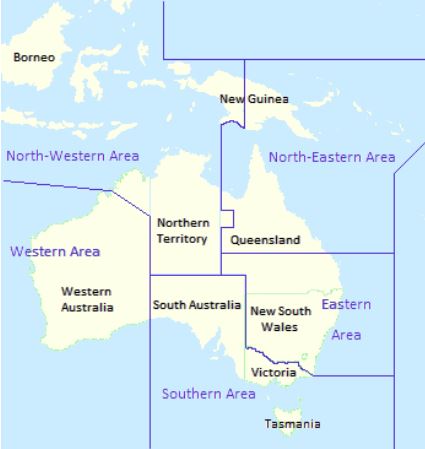Difference between revisions of "HQ Southern Area RAAF"
From Our Contribution
(→Brief History) |
|||
| Line 26: | Line 26: | ||
* No. 36 (Transport) Squadron | * No. 36 (Transport) Squadron | ||
''General Reconnaissance School, Cressy'' | ''General Reconnaissance School, Cressy'' | ||
| − | ''No. 7 (General Reconnaissance) Squadron, Bairnsdale'' | + | ''No. 7 (General Reconnaissance) Squadron, Bairnsdale''<br> |
| − | ''No. 7 Fighter Sector Headquarters, Melbourne'' | + | ''No. 7 Fighter Sector Headquarters, Melbourne''<br> |
''RAAF Station Richmond'' | ''RAAF Station Richmond'' | ||
* No. 6 (General Reconnaissance) Squadron | * No. 6 (General Reconnaissance) Squadron | ||
Revision as of 16:39, 25 November 2023
 RAAF area commands in November 1942 | |
Brief History
Prior to World War II, the Royal Australian Air Force was small enough for all its elements to be directly controlled by RAAF Headquarters in Melbourne. After war broke out in September 1939, the Air Force began to decentralise its command structure, commensurate with expected increases in manpower and units. Between March 1940 and May 1941, the RAAF divided Australia and New Guinea into four geographically based command-and-control zones: Central Area, Southern Area, Western Area, and Northern Area.
HQ Southern Area was formed in March 1940, and initially controlled units located in Victoria, Tasmania, South Australia and southern New South Wales. Headquartered in Melbourne, Southern Area Command was responsible for air defence, aerial reconnaissance and protection of the sea lanes within its boundaries. From 1942 its operational responsibilities excluded New South Wales.
As at 30 April 1942, Southern Area's order of battle comprised:
RAAF Station Laverton
- No. 5 (Army Cooperation) Squadron
- No. 36 (Transport) Squadron
General Reconnaissance School, Cressy
No. 7 (General Reconnaissance) Squadron, Bairnsdale
No. 7 Fighter Sector Headquarters, Melbourne
RAAF Station Richmond
- No. 6 (General Reconnaissance) Squadron
- No. 22 (General Purpose) Squadron
- No. 30 (Long Range Fighter) Squadron
- No. 100 (General Reconnaissance) Squadron
RAAF Station Canberra
- No. 4 (Army Cooperation) Squadron
- No. 18 (Heavy Bomber) Squadron
- Survey Flight
RAAF Station Rathmines
- No. 9 (Fleet Cooperation) Squadron
- Seaplane Training Flight
No. 2 Fighter Sector Headquarters, Newcastle
Unit Personnel
- Albert Walmsley 15 Jun - 27 Jul 1944
Notes